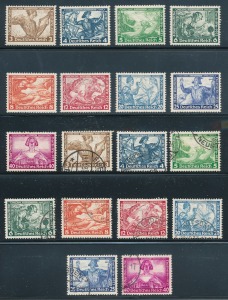
When the Nazis took power in Germany in 1933, it didn’t take them long to completely alter the stamp issuing policy of the Wiemar Republic. Perhaps most illustrative of the change is the Wagner set issued within a few months of the Nazi takeover of the German government. Wiemar stamps are calm and placid with bucolic country scenes, nonpolitical German heroes and old rural castles. Richard Wagner, whose operas are illustrated on this early Nazi set, was a fiercely Germanic composer and antisemite. He was a bold tonal innovator in music and like Hitler, who felt that he was destined to lead, felt divinely inspired to change the future of music. The operas of Wagner are largely based on Germanic myths and portray the Germanic nation as different and chosen. Stamps are a wonderful way for a government to pound home its subliminal message.
The Nazis believed that Germans were genetically superior to other races and deserved to rule them. There was a strong militaristic quality to Nazism and Hitler began preparing for war from the time he attained power. The Wagner set complimented these aims. The myths that the Wagner operas extol and more importantly the emotional level on which his music satisfies is consistent with the fascist call to action. Issues are never negotiated only fought over. And every issue is of life and death significance with the end of the Ring of the Nibelungen being the destruction of Valhalla and the ending of the reign of the gods. Hitler saw this as a metaphor for his rule-with the Nazi Reich being the successor to the gods. But probably unconsciously he saw he and his compatriots as the gods themselves and, knowing that even Nazi Germany couldn’t conquer and rule the world, was attracted to the pathos of Wagner as foretelling his own, and Germany’s, disaster.

